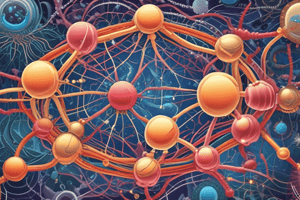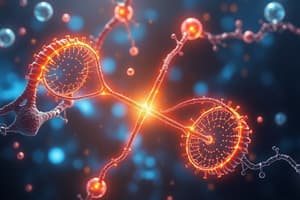Podcast
Questions and Answers
What role does UCP1 play in brown adipose tissue (BAT)?
What role does UCP1 play in brown adipose tissue (BAT)?
- It allows protons to generate heat instead of ATP. (correct)
- It stores energy as fat.
- It helps produce ATP efficiently.
- It decreases the temperature of the tissue.
How does the proton leak in reptiles compare to that in mammals and birds?
How does the proton leak in reptiles compare to that in mammals and birds?
- Reptiles have a much lower proton leak. (correct)
- Mammals and birds have a significantly lower proton leak.
- Reptiles have a higher proton leak.
- Proton leak is the same across all species.
What was the initial belief about brown adipose tissue (BAT) depots in adults?
What was the initial belief about brown adipose tissue (BAT) depots in adults?
- BAT depots in adults are predominantly located on the abdomen.
- Adults do not have BAT depots.
- Adults have smaller and less predictable BAT depots compared to newborns. (correct)
- BAT depots are only found in overweight adults.
What is one consequence of the uncontrolled uncoupling mechanism caused by DNP?
What is one consequence of the uncontrolled uncoupling mechanism caused by DNP?
Where are the most predictable locations of brown adipose tissue (BAT) depots in adult humans?
Where are the most predictable locations of brown adipose tissue (BAT) depots in adult humans?
Why is the process of uncoupling in cells regulated?
Why is the process of uncoupling in cells regulated?
What substance was historically used as a weight loss drug due to its uncoupling effects?
What substance was historically used as a weight loss drug due to its uncoupling effects?
How do scientists identify regions of high glucose uptake in humans?
How do scientists identify regions of high glucose uptake in humans?
What does the proton motive force primarily couple in cellular respiration?
What does the proton motive force primarily couple in cellular respiration?
Which type of tissues is most specialized for heat production due to high mitochondrial content?
Which type of tissues is most specialized for heat production due to high mitochondrial content?
What is a key role of the proton gradient in prokaryotes?
What is a key role of the proton gradient in prokaryotes?
How is energy dissipated in instances where ATP is not produced?
How is energy dissipated in instances where ATP is not produced?
What is the significance of Uncoupling Protein 1 (UCP1) in brown adipose tissue?
What is the significance of Uncoupling Protein 1 (UCP1) in brown adipose tissue?
Which complex is involved in setting up a proton pump in prokaryotes?
Which complex is involved in setting up a proton pump in prokaryotes?
What is produced as a result of the electron transport chain in mitochondria?
What is produced as a result of the electron transport chain in mitochondria?
What is a major function of ATP synthase?
What is a major function of ATP synthase?
What is the primary function of ATP synthase?
What is the primary function of ATP synthase?
How does the action of protons through ATP synthase lead to ATP production?
How does the action of protons through ATP synthase lead to ATP production?
What role does the central stalk play in ATP synthase?
What role does the central stalk play in ATP synthase?
Why is ATP synthesis considered energetically unfavorable?
Why is ATP synthesis considered energetically unfavorable?
What structural feature of ATP synthase allows the F1 subunit to flex during rotation?
What structural feature of ATP synthase allows the F1 subunit to flex during rotation?
What happens to ADP and inorganic phosphate during ATP synthesis?
What happens to ADP and inorganic phosphate during ATP synthesis?
What characteristic structure forms the folds in the inner mitochondrial membrane associated with ATP synthase?
What characteristic structure forms the folds in the inner mitochondrial membrane associated with ATP synthase?
Why can't protons pass through the inner mitochondrial membrane on their own?
Why can't protons pass through the inner mitochondrial membrane on their own?
Flashcards are hidden until you start studying
Study Notes
ATP Synthesis
- ATP synthesis is the process of producing ATP from ADP and inorganic phosphate (Pi). This process is energetically unfavorable and requires energy input.
- ATP synthase is a molecular machine that harnesses the energy from the proton gradient to drive ATP synthesis. It consists of two subunits: FO and F1.
- F1 rotates in relation to FO, which is anchored in the membrane.
- Protons move through a channel in FO and bind to a ring on FO, causing it to rotate. These protons then exit from FO into the lumen.
- The torque is transferred to the F1 subunit by a central stalk, causing a conformational change in F1.
- F1 is made of three dimers arranged in a ring. ADP and Pi bind in the gap between two dimers. Rotation of the stalk causes the dimers to squash together, which fuses ADP and Pi to form ATP.
- ATP synthase dimerizes, creating folds in the inner mitochondrial membrane called cristae, which focuses the proton gradient near ATP synthase and improves efficiency.
Proton Motive Force
- The proton gradient couples oxidation of fuels by the electron transport chain (ETC) to phosphorylation of ADP by ATP synthase.
- The proton motive force is the energy stored in the proton gradient, which is used to drive ATP synthesis.
- The proton motive force can also drive active transport processes, such as the entry of pyruvate into the mitochondria, the entry of ADP, and the exit of ATP.
Uncoupling
- Uncoupling is the process of dissipating the proton gradient as heat instead of using it to drive ATP synthesis.
- Brown adipose tissue (BAT) is highly vascularized and contains many mitochondria, which allows it to efficiently produce heat.
- White adipose tissue (WAT) contains few mitochondria and is specialized for fat storage.
- UCP1 (uncoupling protein 1) is a protein that allows protons to move back across the mitochondrial membrane, dissipating the proton gradient as heat.
Dinitrophenol (DNP)
- DNP is a chemical that uncouples the electron transport chain from ATP synthesis by collapsing the proton gradient in an uncontrolled way.
- DNP can cause serious side effects, such as hyperthermia, due to uncontrolled heat generation.
- DNP can also lead to cell death due to the inability to produce enough ATP.
BAT and Weight Loss
- Adult humans possess BAT, which helps regulate body temperature and has emerged as a potential target for weight loss.
- BAT is found in small, scattered depots throughout the body, particularly under the clavicles.
- The idea of "browning" WAT to increase BAT activity is being investigated as a potential strategy for weight loss and improved metabolic health.
Studying That Suits You
Use AI to generate personalized quizzes and flashcards to suit your learning preferences.




